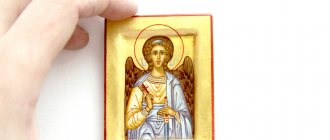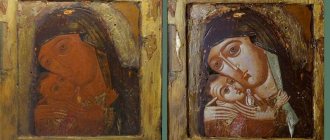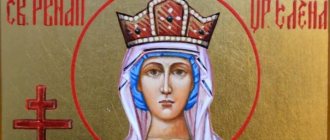In general, icon painting originated in Byzantium. Byzantine icon painters managed to create a visible image of the Almighty and show it to the world. It is not surprising that the entire Orthodox world accepted this way of incarnating God, and icon painting culture spread to all countries.
Of course, Byzantine icon painting did not develop overnight. It is customary to distinguish six periods in the development of icon painting:
The pre-iconoclastic period began in the 6th century AD and lasted about a hundred years; The iconoclastic period lasted from 730 to 843; The Macedonian period began in 843 and ended only in the 12th century; Komnenian period - occupied the 2nd half of the 11th century; 13th century ; The Palaiologan period - the shortest, took only the first decades of the 14th century.
Pre-Iconoclastic period
The icons of this period are characterized by the following features: the images were rough and schematic, since the icon painters did not draw small details; due to the schematic nature of the image, the icons were similar to each other. Icon painters of this time used a special painting technique (the so-called encaustic), which made it possible to preserve icons in their original form for a long time. Thanks to this, icons painted in the 6th and 7th centuries have survived to this day. The most famous icons of the pre-iconoclastic period are “Christ Pantocrator” and “Apostle Andrew”.
Symbolism and images of the Byzantine icon
The new artistic concept contributed to the final change in the previous symbolism, which was marked by a transition from the old naturalistic perception of the sensory world to a more religious and sacred reflection of it. Now the images of Byzantine icons adhere to other handwritten canons.
An icon is a kind of window into the spiritual world. Hence its special language, where each sign is a symbol denoting something greater than itself. The face on the icon is a face turned towards God, a personality transformed in the light of eternity.
The face in an icon is the most important thing, and the most important thing in the face is the eyes. The well-known expression “the eyes are the mirror of the soul” was born in the Christian worldview.
The icon also attaches great importance to the hands, which say a lot about a person’s personality. Each hand gesture is interpreted in its own way, carries certain spiritual information, and each new situation has its own gesture. The icon painter, as a rule, painted the face and hands very carefully.
The figures were usually depicted as if “lightened”, so that the body looked weightless and ethereal. The bodies in the icons seem to float in space, hovering above the ground. The iconographic image seeks to convey the combination of external fragility and internal power. The bodies on the icons have elongated proportions, which is an expression of the spirituality of man, his transformed state. The icon shows us the image of a new man, transformed, chaste.
Like any work of painting, an icon deals with color. The background of the classical Byzantine icon is gold. It is both color and light. Gold denotes the radiance of Divine glory, it is uncreated light, a symbol of Heavenly Jerusalem. The golden color serves as an expression of what is most valuable in the spiritual world. The color closest in meaning to gold is white.
It also represents colors and light at the same time, but is used much less often than gold. White color symbolizes purity, innocence and involvement in the divine world.
Red and blue colors usually appear together. They symbolize mercy and truth, beauty and goodness, earthly and heavenly, that is, those principles that are divided and opposed in the fallen world, but unite and interact in God.
Depending on the degree of holiness of the heroes who are presented in biblical mythology, the names of their faces began to be divided into categories such as:
- Apostles;
- Unmercenaries;
- The faithful;
- Great Martyrs;
- Martyrs, etc.
There are 18 species in total. A clear example demonstrating the application of new artistic canons is the icon of Jesus Christ in the Byzantine style, which is called Christ Pantocrator.
Its creation was based on new color forms, which are a combination of natural and powder paints mixed in liquid.
The main facial features that the artist managed to give to this shrine turned out to be so natural and correctly conveyed that in other subsequent works, God’s gaze began to be presented in exactly the same form that preceded the previously created original.
Iconoclastic period
This period became the most difficult in the development of Byzantine icon painting, which had not yet been fully formed. In the thirties of the eighth century, an active and brutal struggle against religious opponents began in Byzantium. As a result of this struggle, many icon painters were declared heretics, and their works were destroyed. Instead of icons, artists were instructed to depict animals, plants, scenes from everyday life, etc. But this could not stop the development of icon painting. Many masters left for remote corners of the empire and continued their work. Italy became the center of icon painting, where many Byzantine icon painters moved.
History of Byzantine icons
The widespread veneration of icons in Byzantium is already attested by many literary monuments of the 7th century.
“I draw and write Christ and the sufferings of Christ in churches and houses, and in squares, and on icons,” wrote one of the authors of that era, Leonty of Hierapolis, “so that, seeing them clearly, I can remember and not forget. ... And just as you, when you worship the book of the Law, worship not the nature of the skins and ink, but the words of God found in them, so I worship the image of Christ. Not the nature of wood and paints... but, worshiping the inanimate image of Christ, through him I think of embracing Christ Himself and worshiping Him..."
Byzantine iconography is an ancient religious genre of medieval painting, where the authors had to visually illustrate images of mythical characters taken from the Bible. Images of sacred persons, which Roman artists were able to fully display on a solid surface, began to be called an icon.
The creation of the first Byzantine icons was based on an ancient writing technique that gained wide popularity in ancient times. It was called encaustic.
In the process of using it, icon painters had to dilute their paints by mixing them with wax, which was the main active ingredient. Its unique formula, covering the outer side of the sacred canvas, allowed the icon to retain its original appearance in its original original form for a long time.
In addition, the main facial features that reflect the true view of religious personalities were presented by artistic creators very superficially, with a lack of precise detail. That is why in the first works, the Pre-Iconoclastic period, covering the period of the 6th - 7th centuries, one can immediately draw attention to the rough and in some places blurred facial features. Among their main works is the Sinai icon of the Apostle Peter.
Further, with the advent of the Iconoclastic period, the traditional creation of religious icons turned out to be extremely difficult. First of all, this was due to new socio-political movements that were actively undertaken in Byzantium for several hundred years. Ardent opponents of religious culture sought to completely ban the centuries-old veneration of icons, through their complete destruction.
However, Byzantine icons continued to be created, carrying out this process in strict secrecy from government supervision. At that point in time, the current icon painters decided to completely change the previously established attitude towards understanding the church faith.
Pre-Iconoclastic period
The icons of this period are characterized by the following features: the images were rough and schematic, since the icon painters did not draw small details; due to the schematic nature of the image, the icons were similar to each other.
Icon painters of this time used a special painting technique (the so-called encaustic), which made it possible to preserve icons in their original form for a long time. Thanks to this, icons painted in the 6th and 7th centuries have survived to this day. The most famous icons of the pre-iconoclastic period are “Christ Pantocrator” and “Apostle Andrew”.
Iconoclastic period
This period became the most difficult in the development of Byzantine icon painting, which had not yet been fully formed. In the thirties of the eighth century, an active and brutal struggle against religious opponents began in Byzantium. As a result of this struggle, many icon painters were declared heretics, and their works were destroyed.
Instead of icons, artists were instructed to depict animals, plants, scenes from everyday life, etc. But this could not stop the development of icon painting. Many masters left for remote corners of the empire and continued their work. Italy became the center of icon painting, where many Byzantine icon painters moved.
Even secular historians admit that the culture of Byzantium during the times of iconoclasm was marked by decline. The “Triumph of Orthodoxy” led to a cultural upsurge that lasted several centuries. But as a result of the 4th Crusade, the Western crusaders sacked Byzantium and captured Constantinople in 1204.
The “Golden Age” of the Byzantine icon is over. Later, Orthodox Byzantium regained its independence and achieved new cultural achievements, but the iconographic masterpieces of subsequent times were created outside Byzantium. In 1453, the Byzantine Empire died from the Turkish invasion...
Post-iconoclastic period
The post-iconoclastic period became the heyday of Byzantine icon painting. It was during this period that the icon painted on a board became widespread and became an integral part of the temple interior.
Icon boards are made mainly from cedar and cypress. Icons come in different sizes and different shapes. As a rule, an ark is carved into the icon - a field up to 10 mm deep, repeating the shape of the board. The main image is placed inside the ark, and the fields of the icon either remain free or additional images are placed on them.
The basis of this style were icon samples painted by Greek masters.
Gold plays an important role in Byzantine icon painting of the post-iconoclast period. Many icons are written on a gold background. The material for this background is thin sheets of gold leaf, applied with glue over gesso and then carefully smoothed. Gold is also used to decorate various items of clothing.
In this case, the design is applied to the icon using garlic juice, which has the properties of glue; then a sheet of gold leaf is placed on the surface, which adheres to the surface of the icon in those places where the design was made with garlic juice; then unnecessary parts of the gold leaf are cleaned off the surface.
Komnenian period
This period is characterized by a change in style. Icon painters again returned to the ancient style, leaving the ascetic one. The images on the icons take shape. The faces of saints become more alive and have individual features.
The clothes of the saints are well drawn. The most striking examples are: “The Vladimir Icon of the Mother of God,” painted in Constantinople; mosaic icon “Christ Pantocrator the Merciful”; icon "Gregory the Wonderworker".
The appearance of hagiographic images
At the very beginning of the 13th century, the center of Byzantium, Constantinople, was plundered and destroyed by crusading knights. For some time, icon painting workshops stopped working. However, the tragic events could not stop the development of icon painting; on the contrary, a new type of Byzantine icon was formed - hagiographic icons, that is, depicting scenes from the lives of saints.
Until this time, pictures of the lives of saints were depicted exclusively on the pages of church books. In the very first decade, scenes from the life of the saint began to be depicted on icons. In the center of the icon was the face of the saint himself, and around the perimeter were paintings from his life. Vivid examples of hagiographic icons are the icon of St. Nicholas and the icon of St. Catherine.
Palaiologan period
In the middle of the 13th century, Constantinople was returned by the Greeks, which could not but leave its mark on icon painting traditions. During this period, the influence of ancient culture and art is felt. The icons of this period are quite different from the earlier icons.
The faces of the saints are depicted very well; one gets the feeling that the icon painter was painting a portrait of the saint. The real masterpieces of the Palaiologan period are: the icon “St. Theodore Stratelates”, the icon “Twelve Apostles”, the icon “Christ Pantocrator”.
Macedonian period
In the forties of the ninth century, the iconoclastic period ended, and icon painting traditions were given the opportunity to continue and develop. At the same time, a new style in icon painting was emerging - the ascetic style. The basis of this style were icon samples painted by Greek masters. The features of this style are as follows: the icon painters tried to focus the viewer’s attention on the face of the saint, so small details and “extra” decorations were absent from the icons; the faces of the saints were completely devoid of emotions and feelings, they expressed practically nothing; The main object of the entire image was the huge eyes with a frozen gaze. A typical example of an icon from the Macedonian period are two icons of Our Lady Hodegetria, which have survived to this day.
Influence on Old Russian iconography
The icons of Byzantium, in all their aesthetic splendor, managed to make an invaluable contribution to the development of ancient Russian iconography. Since the main founders of cultural and religious education, first of all, it is the Roman icon painters who should be singled out. They managed to pass on their accumulated knowledge on creating church splendor not only to their future generation, but also to other states that existed at that time, one of which was Ancient Rus'.
( 1 ratings, average: 5.00 out of 5)
Palaiologan period
In the middle of the 13th century, Constantinople was returned by the Greeks, which could not but leave its mark on icon painting traditions. During this period, the influence of ancient culture and art is felt. The icons of this period are quite different from the earlier icons. The faces of the saints are depicted very well; one gets the feeling that the icon painter was painting a portrait of the saint. The real masterpieces of the Palaiologan period are: the icon “St. Theodore Stratelates”, the icon “Twelve Apostles”, the icon “Christ Pantocrator”.
Share link









